|
Back in 1981, the first wave of Hong Kong martial arts movies had come and gone and made a serious impact on American action cinema. Back then, western audiences tended to generalise about such things. They probably still do. As many will now know, martial arts come in a variety of guises, but in the 70s they tended to get lumped together under the single and misleading umbrella of kung fu. Nowadays we all know what a ninja is, but they were a surprisingly long time coming to American genre cinema. The reason is simple – almost all of the 70s martial arts movies that reached western shores originated from Hong Kong, and ninjas are Japanese in origin. We learned about samurai from Kurosawa movies, but Kurosawa never made a ninja film. No, our introduction to the Japanese ninja came in the shape of three films made by exploitation specialists Cannon Films in the early 1980s and their box office popularity kicked off a wave of American made ninja movies, including Cannon's own American Ninja series.
The original Cannon trilogy – Enter the Ninja, Revenge of the Ninja and Ninja III: The Domination – have been brought together here as a dual format Blu-ray and DVD set by Eureka, who are starting to give Arrow some serious competition when it comes to cult movie Blu-ray and DVD releases. All three have their devoted fans. I have to admit to being a tad more cynical than some others (no, really?), but midway through my viewing of this trilogy – which I never caught back when they were first released – I still got the surprise of my life.
And so to the films.
Enter the Ninja. Like Enter the Dragon, the film from which it unashamedly cribbed its title, I always felt there should be a comma in there to avoid any sleazy misreading of what it's actually about. Of course, if you have a bit of a thing for Franco Nero, feel free to read it any way you please. One thing you can be sure of from the start in this cheesy but once popular action exploitation flick from 1981 is that despite the presence of a good many ninja warriors in the opening scene, here Franco Nero is definitely the ninja. There's just one thing, he's dressed from head to toe in the brightest white. It's a colour that was not really favoured by real-life ninjas, who were all about stealth and sinking into the shadows. I could see this guy in the dead of night if my eyes were closed and the moon was covered by cloud. Not so the goons who are hunting him down, red-dressed ninjas (red!) who it turns out are trying to kill him in a final test of his skills at a Japanese ninja school. His name is Cole, and this graduation exam appears to require him to slaughter his fellow students. There's only one black-dressed ninja here, and that's Hasegawa (real life ninpo expert Shô Kosugi), who does not believe that a westerner like Cole could ever be regarded as a ninja and is established quickly as his nemesis. Hang on a second, the Caucasian good guy is dressed in white and the oriental bad guy wears black? What, seriously?
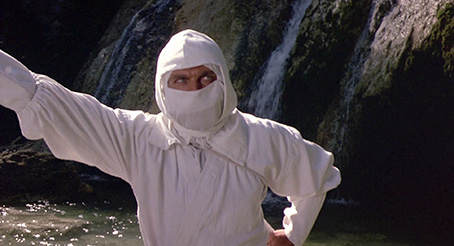
As it happens, Hasegawa is not really the bad guy, more an angry weapon to be called on to offer a climactic challenge for Cole when all other attempts to destroy him have failed. The real bad guy's name is Venarius and he's played by 80s exploitation fave Christopher George in a performance that some might just describe as larger than life. He's a ruthless and obscenely wealthy American industrialist who's looking to grab land being farmed by Cole's old friend and former war buddy Frank (Alex Courtney) in the Philippines. Frank's become a little too fond of the booze, but luckily for him he has an attractive and take-no-crap wife in the shape of Mary Ann, played by a typically feisty Susan George. When Venarius's men – led by a creepy, foreign accented stump of a man with a hook for a hand and whose name is (wait for it) The Hook – try to scare away Frank's workers by beating them senseless, Cole decides to stick around and put his newly qualified ninja skills to work in the name of social justice.
That director Menahem Golan – one half of the Cannon Group whose fortunes this film helped to turn around – opted for a white male protagonist to introduce these hitherto unexploited martial arts practitioners to an American audience was, and to a degree still is, par for the movie course. Even a fighter of Bruce Lee's considerable skill and charisma was only allowed to carry an American film if he had John Saxon and Jim Kelly on hand to serve as identification figures for a conservative domestic audience. Later, when Hollywood looked to cash in on the breakthrough success of the Hong Kong funded Rumble in the Bronx, they only seemed prepared to put the multi-talented Jackie Chan in the lead if he was teamed with a bankable American star.
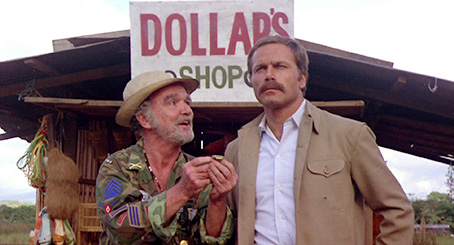
But Franco Nero is no Bruce Lee or Jackie Chan. If we're being brutally honest, he's not even a poor man's John Saxon or Jim Kelly either. For the most part it doesn't matter that much, as Nero's physicality and some deft work by action doubles and editors Michael Duthie and Mark Goldblatt do a fair job of selling his fight skills as real. That said, the very notion of him fighting and defeating Hasegawa seems unlikely from the start, as it's clear that this Japanese martial arts master could wipe the floor, walls and ceiling with this cowboy moustached pretender. If you're looking for evidence, keep an eye on how each of them handle nunchuks – while Cole struggles to do anything substantial with them in his morning exercises, they whirl smoothly around Hasagawa's body at dizzying speed.
Even viewed in retrospect, Enter the Ninja is a somewhat oddball concoction. Released 9 years after Enter the Dragon set the standard for martial arts choreography in American action movies, its fights aren't that special, the provocation to action is absolutely by the numbers, and it sometimes feels silly when trying to be tense. Cole himself is also a bit of a dick, one who supports his good friend by sleeping with his wife. It's still oddly likeable, but I couldn't help wondering how much tastier the film might have been had Shô Kosugi and Franco Nero swapped roles. Which brings me nicely to...
Any suspicions that this follow-up to Enter the Ninja will be striving for cultural authenticity are dispelled by the opening shot of Kyoto's iconic Golden Temple and a caption that assures us this is "Tokyo, Japan." Well you're half right. A peaceful Japanese family garden scene is then rudely interrupted by the arrival a small army of black-clad ninjas, who proceed to mercilessly slaughter the assembled women, old men and children.
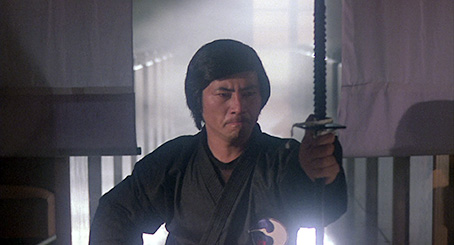
Just as I was wondering why it took all these warriors to accomplish something that could have been done by one man and an automatic pistol, the real target of their assault turns up in the shape of Cho Osaki, played by Shô Kosugi, the multi-skilled bad ninja from the previous film. He's accompanied by his friend, a broad shouldered American named Braden who's attempting to persuade Cho to move to the USA and sell his art there. On seeing the grisly result of the assault, the shocked Cho immediately springs into action, and given how this film's predecessor played out, I was fully expecting Braden take the lead here and show the Japanese how American ninjas fight. But when Cho goes after the killers, the first thing Braden does is whip out a pistol. No ninja master he. At least that's what we're encouraged to believe at this stage. And while Braden does dispatch a couple of the bad guys, it's largely down to Cho to fight and defeat them, which does with a skill and agility that had me bouncing with excitement. When the battle is over and the ground is carpeted with bodies, Cho discovers that the ninjas failed to kill his elderly mother or his baby son Kane, who was hidden in woodland and kept handily quiet until it comes time to alert his father to his presence.
Six years later, Cho has moved to Salt Lake City and put his ninja past behind him. Not so young Kane, who when bullied by a group of older local kids shows them just what it means to mess with the son of a ninja. And this kid is good. Given that he's played by Shô Kosugi's own son (also named Kane), we perhaps shouldn't be surprised, but he was just 8 years old at the time of filming and even then could probably have kicked Franco Nero's ass. Cho, meanwhile, is preparing to open a gallery of oriental dolls imported from his homeland. Braden is acting as his business partner, and his assistant is the lively and attractive Kathy, who also practices martial arts (well, sort of) and seems to be awfully fond of Cho.
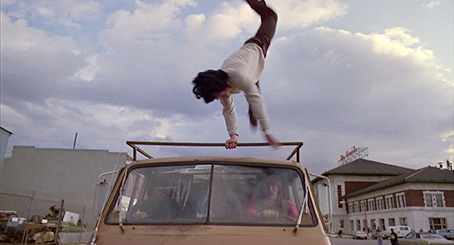
By this point it has become delightfully clear that against all expectations, Cho is clearly the lead player here and he's not going to be saddled with an American sidekick. What, not even Braden or the doting Kathy? No sir. We know this early on because Braden and Kathy are revealed to be using Cho's imported dolls to smuggle heroin into the country, and Braden is actually a secret ninja, one whose silver mask allows stunt co-ordinator Steve Lambert to double for him in the action scenes. Wait a minute, are you telling me the Japanese martial artist is the good guy and the good-looking Americans are the bad guys? Wow, how cool is that?
There are conflicting reports about how we arrived at the film we have here. In Mark Hartley's entertaining documentary Electric Boogaloo: The Wild, Untold Story of Cannon Films, editor Mark Helfrich and music supervisor Richard Kraft claim that the first preview screening was such a disaster that producer Menahem Golan called everyone into his office and made up a string of new scenes on the spot that they then went out and filmed, something he apparently had a talent for doing. On the commentary track on this disc, however, director Sam Firstenberg tells us that his first cut of the film was two hours long, and suggests that the only changes he made were to cut the film down to the Cannon standard running time of 90 minutes and trim a few shots to get the film an R rating (most of which have since been re-instated). Either way, there's nothing about what unfolds here to suggest production problems of any sort. Indeed, given that this was Firstenberg's first stab at directing an action movie, the result is little short of miraculous and wipes the floor with its predecessor on every count. The quietly charismatic Kosugi makes for an engaging lead, the film moves at a belt, and the fights are blisteringly choreographed and staged. Crucially, they're also impeccably shot, with the camera placement and editing showcasing the skills of the performers rather than disguising them in a blitz of bewildering angles and edits, as has become the way in action cinema since. The supporting cast also has its share of genuine pleasures, notably the casting of martial arts master Keith Vitali as Cho's close friend Dave Hatcher (the sequence in which the two spar in Cho's dojo is old-school martial artistry at its best), while in his final film role, Mario Gallo brings the character of Mafiosi-style gangster Chifano colourfully to life.
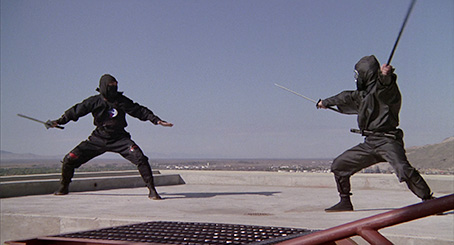
The perceived need to up the ante on the first film when it comes to ninja skills did prompt a couple of double-takes on my part. Just how long did Cho climb, jump and fight with a mouthful of razor-sharp darts in order to spit them in the face of an opponent when required? And just where did Braden get a fully clothed dummy of himself to fool Cho in the climactic fight? I'm also aware I'm not the only one to break out a smile at the band of would-be hard men whose intimidation technique consists of hanging around the park dressed like The Village People.
But even at it's most theoretically unlikely, the action always sits on the right side of plausibility, the result in part of having to stage it all for real rather than cheating it with CGI or wire work. Full credit is due to Shô Kosugi and Steve Lambert here, who were given free reign on the action choreography (Lambert also plays a large number of the assailants and even occasionally doubles for Kosugi himself) and the two deliver the combat goods in spades. Fast, frequent and furious, the fights are some of the best I've seen in an action film for some time and include a couple of genuine show-stoppers, the best of which – involving a criminal gang and a moving van – would not have disgraced Hong Kong-era Jackie Chan. A low budget exploitation action pic it may be, but time and multiple viewings may just see Revenge of the Ninja become my all-time favourite American made martial arts movie.
| Ninja III: The Domination |
|
If you thought Cho's martial arts skills were a cut above the norm in Revenge of the Ninja, the opening sequence in this oddly titled third film in the series (I tend to have certain expectations when a title contains the word 'Domination', expectations that this film was never destined to meet) is likely to prompt a few jaws to quietly drop. After attacking and killing a poorly protected VIP on a golf course, a green-dressed ninja (green!) is pursued by police in a variety of vehicles, who appear on mass out of nowhere like those cops in the Grand Theft Auto video games. He knocks patrolmen off their bikes by swinging around a tree trunk, rides the roof of a police car like a chariot racer, and hijacks a helicopter by leaping onto it from a treetop. Once again, however, it all feels oddly plausible, a testament to the fact that all the stunts were done for real. Credibility takes a running jump when the police surround the ninja and shoot the shit out of him (how these nitwits don't hit each other is a mystery for the ages). Eventually he falls, presumably under the weight of all the lead in his system, but when one of the cops checks the body he leaps back to life and takes up where he left off. Guns are soon a-blazing all over again, and after taking as many bullets as Tony Montana at the end of Scarface, the still living ninja disappears in a puff of smoke. Say, what?
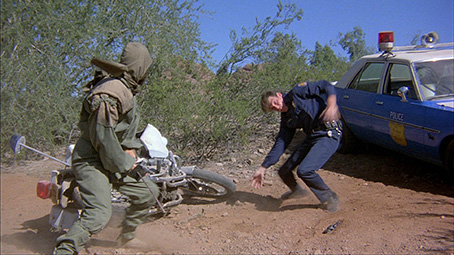
A short while later, he's discovered by a telecommunications repair girl and aerobics instructor (you heard me) named Christie. He's bruised and bloodied and ready to die, but before doing so he hands Christie his sword and looks into her eyes in a way that suggests more than just deadly hardware has just passed between them. She makes a statement at police headquarters, one that curiously doesn't include the gifted sword. As she goes to leave, she is pestered for a date by pushy patrolman Billy Secord, but our Christie doesn't go out with cops. She certainly shouldn't go out with this cop, but we all know she probably will in the end. A short while later, after an aerobics class that has the pumping iron crowd drooling into their jockstraps, she sees one of her female students being hassled by men in that "hey baby" way that was common to 80s exploitation movies. Christie intervenes, and when the goons turn their attention to her she brings them all to their knees with martial arts skills she never knew that she had. As the fight unfolds, Billy shows up and does what all good cops do by watching from the sidelines until it's all over, then making a show of booking Christie for assault so he can make further moves to get into her pants. What a guy.
Then one night, the sword that Christie chose not to mention to the cops starts glowing and floating in the air in front of her. When it happens again the following evening, she goes round to the house of one of the cops who shot the sword's original owner, dresses up as a ninja and terminates him with extreme prejudice. The next day, she follows another of the shooters and kills him in a hot tub, where he's partying with two girls he presumably had to pay to be anywhere near him. Just for the hell of it, Christie kills them aswell. Could she, by any chance, be possessed with the spirit of the dead ninja? You'd better believe it.
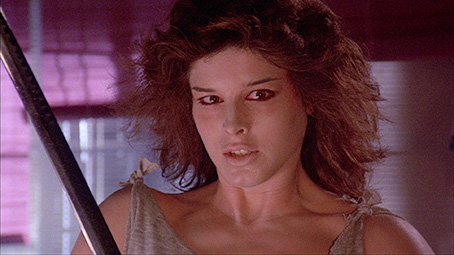
Described by music supervisor Richard Kraft in the aforementioned Electric Boogaloo as a film that "managed to take The Exorcist, a ninja movie and combine it with Flashdance," Ninja III: The Domination is unquestionably the daffiest film in the trilogy, as well as the one that feels most obviously rooted in its time and place. The theoretically good news is that Shô Kosugi once again has star billing. The bad news is that this time here's there on a more advisory basis, an oriental expert on such wayward matters and the one man who knows how to purge Christie of the spirit of this evil ninja. Despite again being choreographed by Shô Kosugi and Steve Lambert and directed by Sam Firstenberg, the fights here are for the most part a shadow of those in Revenge of the Ninja. It probably doesn't help that the best action sequence takes place during the first fifteen minutes, an opening salvo that seems to make promises about spectacular mayhem to come that the film has no intention of keeping. It's still entertaining in its energy and don't-give-a-hoot plotting, though I can't be the only one who raised an eyebrow at director Firstenberg's claim on the commentary track that the only way they could think of to make the notion of a woman with ninja skills believable (note that word, 'believable') was if she was possessed by the spirit of a dead male ninja. No problems there.
All three films appear to have been remastered by MGM and licenced by Eureka for this release. All sport a decent level of detail, well belanced contrast and decent colour, but in other respects the transfers tend to improve as the series progresses. Although a clean-up has clearly taken place on Enter the Ninja, a fair few instances of dust and dirt do still remain. Few were pronounced enough to smack me in the face when I was watching the film, but when they do come they are sometimes hard to ignore (the slow pan over to the white-dressed Franco Nero at the start is one of the worst offenders here) and occasionally the contrast seems to push the highlights perilously close to burn-out. The image is cleaner and the brighter colours more vividly rendered on Revenge of the Ninja and the detail slightly crisper, and there's a slightly richer feel to the image on Ninja III: The Domination, particularly visible in the opening battle between the evil ninja and the cops and the red bathed sequence when Christie goes all Antichristo on us. Black levels are solid on all three films. The first two title are framed 1.85:1, the third 1.78:1.
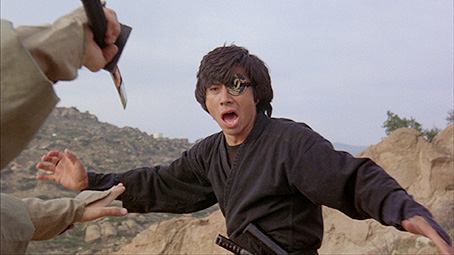
The soundtracks on all three films are Linear PCM 2.0 stereo, or so I've read. The mixes on Enter the Ninja and Revenge of the Ninja have a very mono feel, though are free of damage, background hiss and distortion, and handle music and effects rather well. The dialogue occasionally lacks a little punch, but is always clear. Ninja III: The Domination is the best of the bunch, the stereo having distinct separation and delivering a crisp rendition of music, effects and dialogue.
Optional subtitles for the deaf and hearing impaired are available for all three films.
The extra feature only for Enter the Ninja is a Trailer (2:55), which is in solid shape, loaded with action and makes dizzyingly frequent use of the word 'ninja'.
Revenge of the Ninja Commentary
Hosted by someone whose name flew past so quickly that I didn't catch it (and who says very little here), this commentary by director Sam Firstenberg and stunt coordinator Steve Lambert is a consistently lively and upbeat affair that probably told me as much about the two men as it did about the making of the film. This was clearly a hugely enjoyable experience for both – Firstenberg freely admits he was new to action movie direction and that he learned a lot from Lambert, Kosugi, cinematographer David Gurfinkel and editor Mark Helfrich, while Lambert looks back warmly at the freedom he and Kosugi were given to shape and stage the action scenes how they wanted. Lambert points out in some detail every part he plays (under a variety of ninja costumes, there are scenes where he's actually fighting himself) and deconstructs the stunts involved, the pair identify shots that were cut from the theatrical release, info is provided on supporting players, and both celebrate the days when stunt work was not enhanced by wires or CG. Terrific.
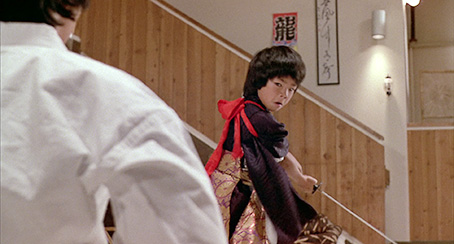
Sam Firstenberg Intro for Revenge of the Ninja (3:15)
The upbeat and likeable Firstenberg explains how a man who had never made an action movie came to make one of the best of all American martial arts movies. As with the commentary, he's generous in his praise for those who taught him what he needed to know.
The Revenge of the Ninja Trailer (1:40) is violent, snappily edited and would have had me queuing outside the cinema on the first day of its release.
Ninja III: The Domination Commentary
Sam Firstenberg, Steve Lambert and that guy whose name I again failed to catch are back for essentially more of the same, which given the cheerfully busy nature of the previous commentary is no bad thing. Again Lambert points out his every appearance, and twice in short succession describes his experience of working on this film as being "like a kid in a candy store" (he said the same about its predecessor on the previous track). Both clearly had as much fun working on this film as they did on Revenge. The nameless one takes a more active role here, asking questions about the film and its making that prompts always interesting responses, and at one point Firstenberg gamely attempt to describe what became known as 'The Cannon Style'. Once again, informative and fun.
Also accompanying the retail release is a Booklet featuring new writing and archival imagery, but we didn't have a copy to comment on.
Fans of 80s exploitation action cinema and especially devotees of the Cannon Films output (you know who you are) should need no prompting here. For Revenge of the Ninja alone I'd be recommending this set, but for all their silliness, the films between which it is sandwiched still have plenty to recommend them, the presentation ranges from pretty good to spot-on, the commentaries are damned good and I've no doubt the booklet is a worthwhile read. Arrow level restorations would have been ideal, but this is still damned good stuff.
|